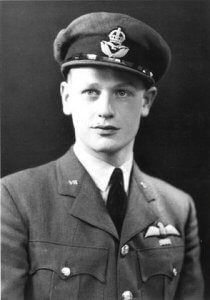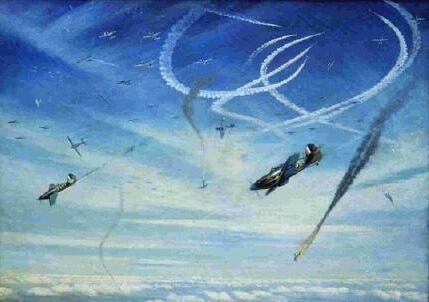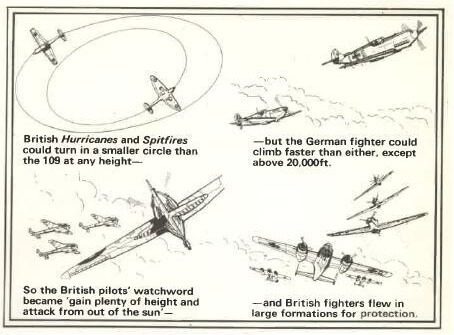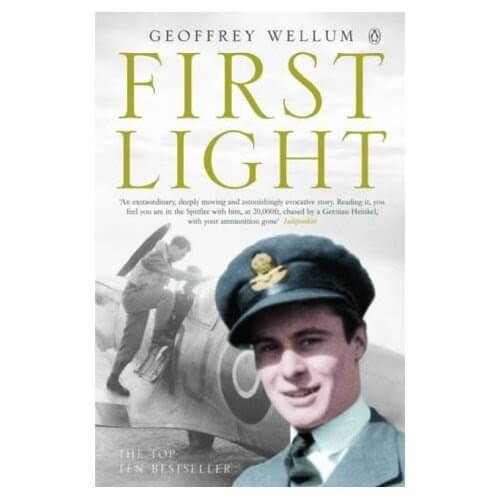As the Royal Air Force celebrates its 100th year in operation this week, as it looks to its past in the air and looks forward to its future in space, two of past its heroes from the RAF’s most celebrated achievement, the Battle of Britain, have passed away. Wing Commander and Battle of Britain ace, Tom Neil, died a few days short of his 98th birthday – and a day after the RAF’s celebratory processional fly pass over Buckingham Palace. A week later one of the youngest fighter pilots in the battle Geoffrey Wellum also departed this mortal coil.
Tom Neil
Based at North Weald in Essex, from the beginning of September 1940, the twenty-year-old Tom Neil flew the Hawker Hurricane fighters during Battle of Britain – becoming an “Ace” in its fierce September air battles.

A young Tom Neil. The Battle of Britain pilots were nearly all in their late teens and early twenties. Courtesy: RAF
Tom was one of the last surviving Battle of Britain “aces” – a pilot with five or more kills – actually he scored nine official kills during the battle with five more added to his tally later. He shot down most of the main types of the Nazi Luftwaffe including the Dornier Do 17, the Heinkel He111, the Junkers Ju87 Stuka bombers and Messerschmitt 109 and 110 fighters. As he fought, he gained two nicknames: “Ginger” due to his hair colour, and “Hawkeye” due to his ability to spot enemy aircraft at a long distance. His aircraft was also shot and hit several times, and he also survived a forced bail out after an air-to-air collision. For his flying exploits, Tom Neil was awarded the Distinguished Flying Cross (DFC) and bar (a second one).
After the battle he was sent to Malta where he flew Hurricanes and later Spitfires and continued to shoot down aircraft there. After that battle Neil was rested in series a ground and training postings including a liaison posting with the US Army Air Corps, but later came to fly fighter-bomber missions in the post D-Day campaign, and again later in Burma. Having originally been a bank clerk who joined as a Voluntary Reserve pilot in 1938, Tom Neil rose to the rank of Wing Commander and eventually stayed in the RAF until 1964. His outspoken nature was perhaps one reason he did not rise further.
Apart from his post war liaison jobs and training duties, Neil did take part in research flights testing pressure suits for high altitude and potential space missions.

RAF Hawker Hurricanes are shown diving this painting which also has the contrails often seen during the Battle of Britain in August and September 1940. Courtesy: RAF Museum
While his many achievements speak for themselves, importantly Tom Neil was also regarded as a very nice man and one who your correspondent was lucky enough to once meet (Battle of Britain pilots are his heroes along with the astronauts of the Mercury, Gemini and Apollo era). By the way, Tom Neil’s friends and admirers were right about him.

The Battle of Britain versions of the Hurricane and Spitfire lacked their Messerschmitt Me 109 opponent fighter’s destructive 20mm cannons. Nevertheless they both could turn better. Courtesy: Visual Books/Macdonald
The late Tom Neil wrote books on his wartime experiences, “Gun Button to Fire” – a reference to arming a fighter’s machine guns – being the most famous. Neil made a point about continuing to support charities supporting the families of pilots killed and wounded in the Battle of Britain. Prince Harry (another nice guy) famously used a picture of Tom Neil and himself on his Christmas card after he gave up a flight as a passenger in a dual control Spitfire in favour of Neil a few years ago.
Tom Neil talks to the BBC about two of his battle experiences here: https://www.bbc.com/news/uk-england-norfolk-44811988
Wing Commander Tom Neil was predeceased by his wife Eileen who had herself served as an Army plotter at RAF Kenley during the Battle of Britain. The couple had three sons (two of which became pilots themselves) who survive him. We salute and thank Tom Neil for all that he did, and give our condolences to them and to his friends.
Geoffrey Wellum
Geoffrey Wellum was still just 18 when the Battle of Britain started in July 1940. Initially posted to protect the port of Bristol in the West Country, Wellum found that he and his 92 squadron were being moved to Biggin Hill in Kent in early September as the RAF wisely rotated its squadrons in and out of the quiet and busy areas. This now posting covered the raging battle area of 11 Group zone of the south east England where most of the air fighting was. By this time aged 19, and nicknamed “Boy” due to his young age, Wellum wisely picked up notes on avoiding being shot down from better pilots at Biggin Hill including his mentor Brian Kingcome and flying ace, Robert Stanford-Tuck. Their sage advice included never flying straight and level for more than a few seconds in the combat area.
Wellum was not quite as successful a fighter pilot as Tom Neil, but shot down one aircraft during the Battle of Britain beginning with a Heinkel He-111 in September with a share in another – a Ju-88 bomber – at the end of the month towards the tail end of the campaign. By then, Hitler postponed his “Operation Sea Lion” invasion when it became obvious in mid-September 1940 that the Luftwaffe’s would not gain air superiority over the RAF in time for an invasion to take place that year. Wellum added three more to his confirmed score during the air battles with Messerschmitt 109 fighters fought mainly over France during the following year, winning the DFC in August 1941. He, like Tom Neil, then found himself being posted to defend the beleaguered island of Malta in 1942.

“First Light” by Geoffrey Wellum was well received by critics. Courtesy: Penguin
Rested from mental exhaustion and sinusitus, Wellum had some test flying and training roles in the latter part of the war. He stayed with the RAF after the war, starting on early Meteor and Vampire jet fighters before moving to B-29s, Canberra jet bombers and eventually V-bombers. After leaving the RAF in 1961 with the rank of Squadron Leader, Wellum became a commodity broker before eventually retiring to Cornwall (by this time divorced from his wife) in the 1980s. There, late in life, he wrote a book “First Light” which was a memoir faithfully describing the hopes and fears of a young pilot going into battle in a Spitfire for the first time. It was well received, becoming a bestseller, and the BBC even produced a television docudrama from it.
Seradata salutes Geoffrey Wellum both for his service and for his book writing, helping others to feel what it was like. We give our condolences to his surviving children and friends.
Post Script: In another sign that the wartime generation of pilots are passing away fast, Mary Ellis, Air Transport Auxiliary (ATA) pilot has died at the age of 101. From 1940 onwards, Women pilots of the ATA were used to ferry replacement aircraft between factories and air stations. This freed up male pilots to do the fighting. Nowadays, women pilots are in the RAF proper and take combat pilot roles. While Mary Ellis joined the ATA after the Battle of Britain, she flew several different types of aircraft including the Spitfire. We salute Mary Ellis and give our condolences to her family.





